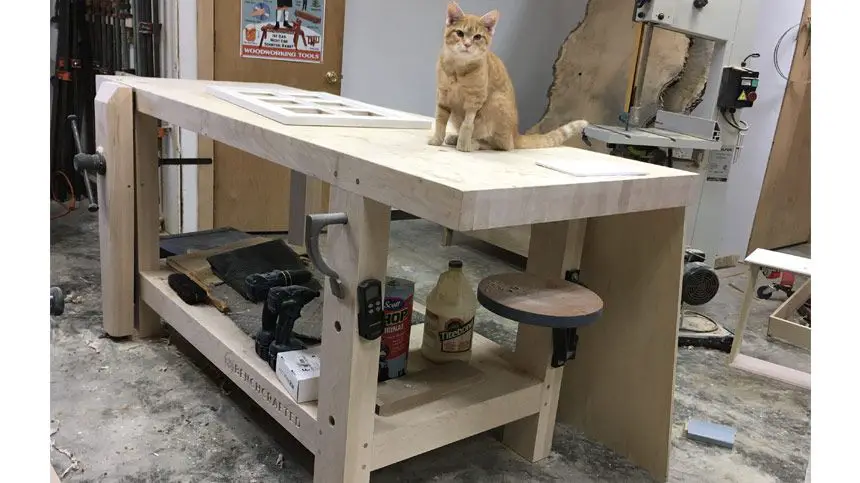Whether it’s cheaper to build or buy a workbench is a common question for those looking to add a sturdy, functional work surface to their workspace. In determining the most cost-effective option, there are several factors to consider including materials, tools required, skill level, customization, and time investment. Weighing these key points will help shed light on if a DIY workbench or store-bought alternative makes the most financial sense.
Page Contents
Cost of Materials
For a DIY workbench, the primary costs come from the building materials needed. These include:
- Wood – The most budget-friendly wood options are pine lumber or plywood sheets. Hardwoods like oak and maple cost more but provide added durability.
- Hardware – At a minimum, you’ll need wood screws, nails, brackets, and potentially corner blocks or an end vise. Opting for higher end bench dogs, vises or storage drawers will raise costs.
- Tools – If you don’t already own basic tools like a saw, drill, level, and tape measure, these will need to be factored into the project budget as well.
- Finish – Applying a protective finish like polyurethane adds expense but helps maintain the bench.
Building a 6 foot simple pine workbench can cost as little as $100-$150 in materials. Upgrading to hardwoods and adding custom features like drawers and vises can quickly raise the cost to $500 or more.
For a store-bought workbench, costs also vary widely. Basic options from home improvement stores start around $150. These make use of inexpensive particle board and laminate constructions. Benches from specialty retailers generally range from $300 to $2,000 or more. Higher end versions are typically made from solid wood and come with built-in storage, vises and other upgrades.
Tools Required
A major perk of buying a ready-made workbench is minimal tools are needed – perhaps just a ratchet to assemble any components. Constructing your own bench requires, at minimum, the following basic tools:
- Circular saw or miter saw
- Power drill
- Tape measure
- Level
- Clamps
- Sandpaper
Many DIYers already have these on hand. But those starting from scratch will need to allocate $150-$300 to acquire the necessary starter tool set.
Skill Level Required
For DIY newcomers, building a workbench can be daunting. Those with only basic skills may find some steps challenging like:
- Achieving precise, square cuts for the benchtop and legs.
- Properly executing structural joinery for a sturdy base.
- Accurately boring holes for bench dogs and vises.
There are ways to simplify the project, like using construction lumber rather than finer hardwood stock. But first-time builders should still expect to make some mistakes and refine techniques throughout the process.
Buying a ready-built workbench removes the need for woodworking skills. Assembly may be required but instructions and all parts are generally included. The use of quality factory joinery also gives store-bought benches an edge in structural stability.
Customization Ability
One of the distinct advantages of making your own workbench is the ability to fully customize it. Options include:
- Sizing – The bench can be tailored specifically to the room and tasks.
- Benchtop – Any desired material and thickness can be used.
- Base design – Choose from a simple leg set-up, storage cabinet, or shelving.
- Benchdogs and vises – Place and specify these to perfectly suit needed tasks.
- Storage – Integrate drawers, cabinets, pegs, and trays as needed.
This flexibility lets you create an optimized, purpose-built work station. Off-the-shelf benches limit you to available sizes and features. Some custom tweaks can be made like adding new bench dogs. But substantially modifying a pre-built bench is difficult compared to DIY versions.
Time Investment
Hand constructing a workbench requires a significant time commitment. The specific hours vary based on:
- Complexity of design.
- Workspace setup and material access.
- Skill level – beginners take longer than experienced builders.
As a general guideline, simple pine workbenches take 15-30 hours for an average DIYer to complete. More complex builds with hardwoods and custom elements can exceed 50+ hours.
In contrast, store-bought workbenches only involve the time needed for delivery and assembly. This may be as short as an hour or up to a day for disassembling, moving, and reassembling large benches.
The hands-on nature of a DIY bench makes it rewarding for those who enjoy woodworking. But if time constraints are a concern, purchasing a pre-built option gets a usable work surface in place much quicker.
Conclusion
Determining whether a DIY or purchased workbench is more economical depends on your priorities. For cost alone, basic store-bought benches are cheaper upfront. But custom DIY builds can potentially save money long-term versus buying high-end pre-built alternatives.
The decision also comes down to personal factors. Building your own workbench makes sense if you:
- Have the necessary skills and workspace.
- Want to fully customize size, features, and design.
- Enjoy hands-on DIY projects and don’t mind investing 20+ hours.
Purchasing a ready-made workbench is likely the better choice if:
- You need something quickly without an involved project.
- Woodworking isn’t your specialty and you value pre-built quality.
- You want something portable or need to accommodate a small space.
Whichever route you choose, invest in the highest quality materials and construction within your budget. A well-built workbench becomes an indispensable heart of any maker’s shop or garage workspace. Taking the time to properly build or research purchase options results in a durable bench that can serve your needs for many years.
